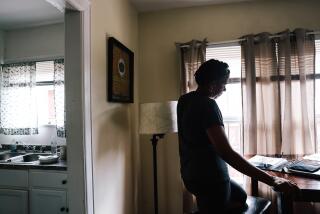Defense Says Print Is Weak Link in Oceanside Slaying-Robbery Case : Crime: Opening statements center on fingerprints in trial of New Mexico man accused of killing an elderly Oceanside woman.
- Share via
Attorneys defending a New Mexico man accused in the 1989 killing of an elderly Oceanside woman focused their attention in opening statements Monday on a single bloody print.
On the first day of the trial in Vista Superior Court, expected to last 10 weeks, public defender Jack Campbell asserted that evidence showed that the tiny print--either from a finger or a portion of a palm--must have been that of the killer.
Yet tests, including those by the FBI, have shown the print could not have been made by his client, 34-year-old Rudolph Roybal, said Campbell.
The print was found on a doorjamb near a garage entrance to the home, away from the blood-spattered hallway where the victim’s body was found.
“If Rudolph Roybal is the perpetrator, it should be his print,” said Campbell, who, along with public defender Kathleen Cannon is representing Roybal.
Roybal is accused of robbing and fatally stabbing 65-year-old Yvonne Weden in her Oceanside home sometime late June 9 or early June 10, 1989, while her husband, Paul Weden, was at work as the night manager of a local supermarket.
Paul Weden discovered his wife’s body dressed in pajamas in a hallway leading to the master bedroom when he returned home from work June 10 and called police, say prosecutors.
Deputy Dist. Atty. James Koerber told jurors that Yvonne Weden was disturbed by an intruder while either asleep or getting ready for bed. The covers on her bed were turned down, and her slippers were by the bed.
“He hit her, he punched her, he stabbed her,” said Koerber. An autopsy revealed she had been stabbed 13 times in the face, neck, chest, side, hands, arms and leg, and there were numerous fresh bruises and scrapes on her face, arms and legs.
Campbell is trying to cut a chain of circumstantial evidence that Koerber said should lead to convictions on charges of murder, robbery and burglary.
Jewelry, including a set of custom-made wedding rings, were taken from the home the night of the killing and found at Roybal’s mother’s home in New Mexico, Koerber said.
He is also asking the jury to find a series of special circumstances, including the use of a knife, killing in the commission of a burglary or robbery and doing great bodily harm to a person over the age of 60.
Conviction on first-degree murder together with the special circumstances could lead to the death penalty or a sentence of life without the possibility of parole.
Prosecutors said that Roybal was frequently seen in the neighborhood before the killings. For about three months, he lived with a stepbrother less than half a mile from the Weden home. While in the neighborhood, Roybal went door-to-door seeking work as a gardener.
He worked as a gardener for the Wedens a week before the the killing. He was fired for working too slowly, prosecutors said.
Roybal left town on a bus for his home in Santa Fe, N.M., the day the body was discovered, according to prosecutors. They said jewelry taken at the time of the slaying, including the wedding rings, were found in a hole in a wall at Roybal’s mother’s home in New Mexico only a few days after the killing.
Prosecutors also said saliva found on a cigarette on the floor of the Weden home by police after the slaying matched Roybal’s blood type.
Campbell sharply criticized the handling of evidence by the police. The section of doorjamb containing the fingerprint has been lost by police since the killing. Subsequent tests have been based solely on a photograph of the print.
The defense attorney said fingerprints taken off the body of Yvonne Weden during an autopsy were of such poor quality that it could not be shown whether or not the prints were made by the victim. Experts were able to rule out both Roybal and the husband, Paul Weden, as a source of the fingerprints, Campbell said.
Campbell also asserted that Roybal was too drunk the night of the killing to have carried out the crime.
He was so drunk, said Campbell, that Roybal’s stepbrother had to lead him to bed, where he passed out fully clothed. At 8 a.m. the next morning, the day the body was found, the stepbrother found him in bed still fully clothed, said Campbell.
More to Read
Sign up for Essential California
The most important California stories and recommendations in your inbox every morning.
You may occasionally receive promotional content from the Los Angeles Times.










